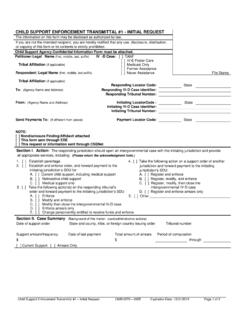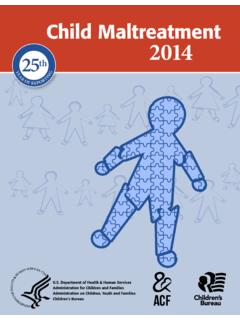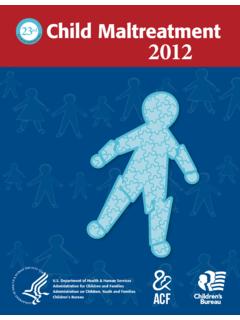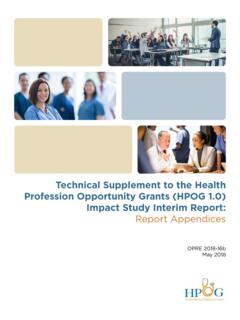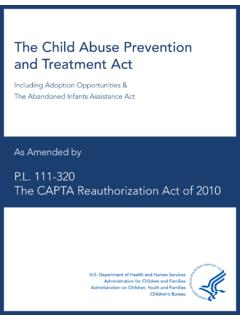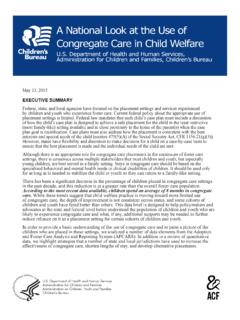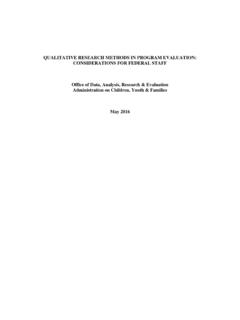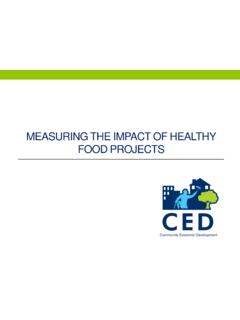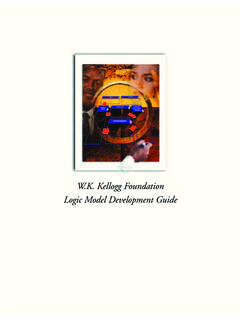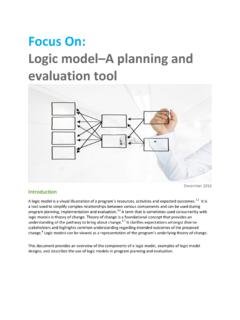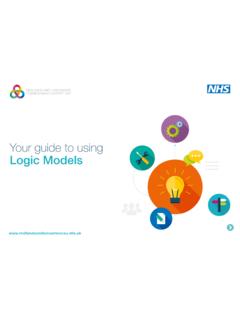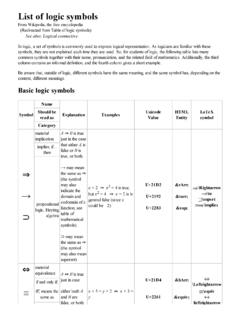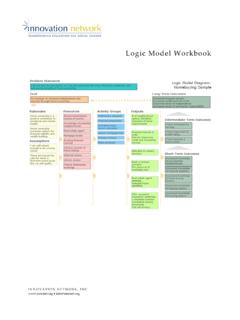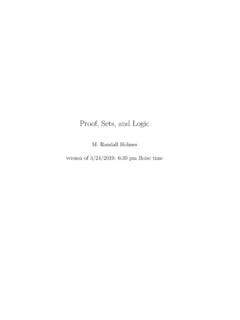Transcription of Logic Model Tip Sheet - Home | Administration for Children ...
1 Logic Model Tip Sheet Logic Models Overview Logic models are effective tools to assist in program planning, implementation, management, evaluation, and reporting. They help define a program's intended impact and goals; the sequence of intended effects;. which activities are to produce which effect; and where to focus outcome and process evaluations. Experts in the field agree that there are connections between program success and using Logic models. What is a Logic Model ? A Logic Model is a graphic illustration of the relationship between a program's resources, activities, and its intended effects. Logic models clearly and concisely show how interventions affect behavior and achieve a goal. They can be described as road maps that specify causal pathways and the step-by-step relationship between planned work and intended results.
2 Specifically, a Logic Model is a visual way to illustrate the resources or inputs required to implement a program, the activities and outputs of a program, and the desired program outcomes (short-term, long-term). What are the Basic Components of a Logic Model ? There are many ways to depict Logic models. Logic models may be simple or complex. The type and complexity of the Logic Model will depend on program focus, the purpose of the Logic Model , and the audience. Sometimes, programs may utilize several Logic models with differing levels of complexity for different purposes and audiences or to highlight different program elements. The simplest form of a Logic Model includes three components: Inputs Activities Outcomes Inputs are the various resources available to support the program ( , staff, materials, curricula, funding, equipment).
3 Activities are the action components of the program ( develop or select a curriculum, write a plan, implement a curriculum, train educators, pull together a coalition). These are sometimes referred to as process objectives. Outcomes are the intended accomplishments of the program. They include short-term, intermediate, and long-term or distal outcomes. Teen Pregnancy Prevention State PREP Logic Models 1. Developing a Logic Model Developing a complete Logic Model can be a lengthy but worthwhile process. There is not just one type of Logic Model format that is right' or the best to use. In developing a Logic Model , one may start from the outcomes and work backward, or start from inputs and activities and work forward.
4 However, before starting, a clear and comprehensive understanding of the specific problem situation that is being addressed must be established ( , high rates of teen pregnancy, lack of services for certain sub-populations, teens' lack of knowledge of contraceptive options). This typically includes reviewing existing data and relevant research as well as conducting a formal or informal assessment of available capacity, inputs, and needs. Often this information is added to a program plan's Logic Model as a problem statement, situation, and/or determinants. There are several resources ( step-by-step guides, templates, on-line training) available to assist in the creation of Logic Model . A resources list is provided at the end of this tip Sheet .
5 Below are tips for writing goal statements, activities (or process objectives), and outcomes (outcome objectives): Goal Statement: A program goal is a very broad statement of intended accomplishments or a description of a general condition deemed desirable. A well-defined goal statement will establish the overall direction and focus for the program, define what the program will achieve and serve as the foundation for developing program strategies and objectives (CDC Evaluation Brief, No. 3a, 2008). Sometimes goals are not always achieved during the duration of the program. Goal statements do not state what will be implemented; rather, they are statements that reflect the results of what will be implemented. They should be specific to the population, setting, and problem to be addressed.
6 Sample Goals: To reduce HIV rates among adolescents in X community. To reduce obesity rates in young adolescents in X state. To improve cardio-vascular fitness in youth participating in X program. A strong Goal Statement . Focuses on a Specific expected program effect in reducing a health problem. Identifies a Priority Population to be served. Is Jargon-free, Short, Concise, and Easily understood Frames outcomes in Positive Terms or in terms of decrease in health risk behavior/outcomes. Avoids use of double negatives. Provides a Framework for identifying strategies and objectives for achieving the goal(s). (CDC Evaluation Brief, No. 3a, 2008). Teen Pregnancy Prevention State PREP Logic Models 2. Activities and Process Objectives: The program activities are often referred to as process objectives.
7 They specify what program staff and partners will do during the program period. Activities are typically more general statements of broad tasks that are written in the Logic Model itself. Sample Activities: Conduct RFP process Develop and pilot training materials Conduct training of trainers Provide technical assistance Process objectives provide more detail for the narrative. A well-written process objective is SMART . Indicates who (priority population) and what (action or activity);. Specific contains an action verb Outlines how much change is expected and how will that change Measurable will be measured Can be realistically accomplished given current resources and Achievable constraints Addresses the scope of the health program and proposes Realistic reasonable programmatic steps toward goals Provides a timeline for meeting objectives.
8 Time-Phased Sample Process Objectives: By year two of the project, staff will have trained 100 health education teachers in the state on the selected scientifically based health education curriculum. By December 30, 2012, health educators will have delivered all lessons from X curriculum to 90% of youth participants in the middle school HIV-prevention program. Of the 300 high risk youth targeted, 80% (240) will complete all 8 prevention education sessions by the end of the school year, 2012. Outcomes: Outcome statements specify the impact or specific intended results of the program. It is often useful to identify short-term and intermediate outcomes. Short-term outcomes are the immediate results of the program.
9 These are the intended knowledge, awareness, attitudes, skills, intentions, etc. Intermediate outcomes specify what individuals do with the short-term outcomes. They are the intended behaviors, practices, and actions. Sometimes long-term outcomes are also identified. Typically, but not always, these mirror the goal statement. It is important to identify the order in which outcomes are expected to be attained which will come earlier and which later. Teen Pregnancy Prevention State PREP Logic Models 3. Outcomes, like activities, are often written more generally in the Logic Model ( increase knowledge of STIs and their consequences, improve condom use skills, increase intentions to abstain from sex, decrease rates of unprotected sex), and written more specifically as outcome objectives in the narrative.
10 Outcomes objectives should also be SMART (Specific, Measurable, Achievable, Realistic, and Time-phased): Sample Outcome Objectives By the end of the project, of the 500 youth participants, 80% (250) will indicate an 80% increase in knowledge regarding where to access reproductive health services, as measured by pre-post surveys. On the 2012 state YRBS, 90% of middle school respondents will report they have not engaged in sex. By June 30, 2012, 95% of 8th grade students who receive the HIV-prevention curriculum will report an increase their assertive communication skills on a post-survey. By June 28, 2012, increase (from 2 to 10) the number of community health centers that have implemented X curriculum to adolescents in their community.
